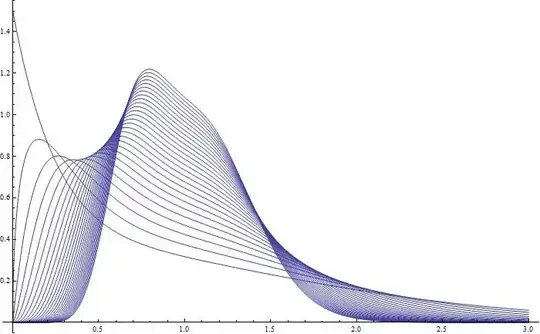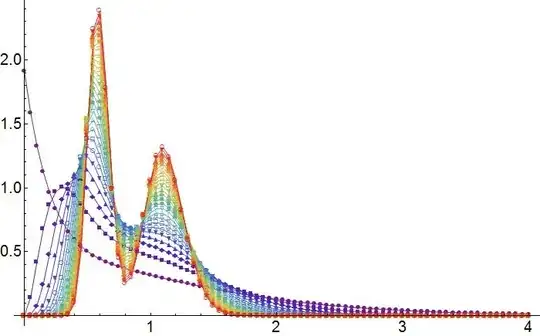Let $N \ge 2$ and $T > N$ be integers.
In multivariate statistics it is of interest to analyze spectra of sample covariance matrices. The resolvent ${\mathfrak g}_M(z)$ encapsulates the whole information about the distribution of eigenvalues of the underlying covariance matrix. We have: \begin{equation} {\mathfrak g}_M(z):= \frac{1}{N} \left< Tr\left[ (z{\bf 1}- {\bf M} )^{-1} \right] \right> \end{equation} where $M:= 1/T \cdot (\tilde{C} X \cdot X^T \tilde{C}^T)$ and $X$ is a $N\times T$ matrix whose elements are independent, identically distributed sampled from a standardized Gaussian distribution and $\tilde{C} \cdot \tilde{C}^T = C$ . The matrix $M$ is a sample covariance matrix in a Gaussian population subject with the underlying covariance matrix being equal to $C$. It is well known that the probability density function of the eigenvalues of $M$ is given as an inverse Stieltjes transform of the resolvent. We have: \begin{equation} \rho(\lambda) = \lim_{\epsilon \rightarrow 0} \frac{1}{\pi} Im {\mathfrak g}_M(\lambda-\imath \epsilon) \end{equation}
Now, by using Symbolic inverse of a linear combination of two matrices and the parametrization of the orthogonal group given in here Itzykson-Zuber integral over orthogonal groups we computed the spectral density in case $N=2$ and the underlying covariance matrix being an identity $C=1$. We have: \begin{eqnarray} {\mathfrak g}_M(z) &=& \frac{1}{N} Tr\left[\left< \frac{(z-a_1) {\bf 1} + {\bf M}}{z^2-a_1 z+a_2} \right> \right]\\ &=& {\mathfrak N}_{2,T} \cdot (2\pi)\int\limits_{{\mathbb R}^2} \frac{(z-a_1) 1+ a_1/2}{z^2-a_1 z+a_2} \cdot \left| \nu_1-\nu_2 \right| \cdot (\nu_1 \nu_2)^{(T-3)/2} e^{-T/2(\nu_1+\nu_2)} d\nu_1 d\nu_2 \\ &=& {\mathfrak N}_{2,T}\cdot (2\pi)\int\limits_{0 < \nu_1 < \nu_2 < \infty} \left[ \frac{1}{z-\nu_1} + \frac{1}{z-\nu_2} \right] (\nu_2-\nu_1) \cdot (\nu_1 \nu_2)^{(T-3)/2} e^{-T/2(\nu_1+\nu_2)} d\nu_1 d\nu_2 \end{eqnarray} where $a_1:=Tr({\bf M})$ and $a_2:=\det({\bf M})$ are the rotational invariants of matrix ${\bf M}$. Here the constant ${\mathfrak N}_{2,T}$ is the normalization factor of the Wishart distribution and it reads: \begin{equation} {\mathfrak N}_{2,T}:=(\frac{T}{2})^T \cdot \frac{1}{\sqrt{\pi} \Gamma(T/2) \Gamma((T-1)/2)} \end{equation} see equation (1.7) page 7 in https://arxiv.org/abs/1610.08104 for example.
Now, by taking the inverse Stieltjes transform we get the spectral density as follows: \begin{eqnarray} &&\rho_{2,T}(z) = {\mathfrak N}_{2,T}\cdot (2\pi)\\ &&\int\limits_{0 < \nu_1 < \nu_2 < \infty} \left[ \delta(z-\nu_1) + \delta(z-\nu_2) \right] (\nu_2-\nu_1) \cdot (\nu_1 \nu_2)^{(T-3)/2} e^{-T/2(\nu_1+\nu_2)} d\nu_1 d\nu_2 \end{eqnarray} The integral above is pretty simple to evaluate and the result reads: \begin{eqnarray} &&\rho_{2,T}(z) dz =\\ && \frac{\sqrt{\pi}}{2 \Gamma(\frac{T}{2}) \Gamma(\frac{(T-1)}{2})} \cdot u^{\frac{T-3}{2}} e^{-u} \left[2\Gamma(\frac{T+1}{2},u)- \Gamma(\frac{T+1}{2}) - 2 u \Gamma(\frac{T-1}{2},u)+u \Gamma(\frac{T-1}{2})\right] du \end{eqnarray} where $u:=z\cdot T/2$. From the above we calculate the spectral moments: \begin{eqnarray} \left< \lambda^p \right> &=& \frac{T^{(p)}}{T^p} \cdot \frac{p \left(\, _2F_1\left(1,p+T;\frac{T+1}{2};\frac{1}{2}\right)-\, _2F_1\left(1,p+T;p+\frac{T+1}{2};\frac{1}{2}\right)\right)+2 (p+T-1)}{2 (2 p+T-1)}\\ &=& \frac{T^{(p)}}{T^p} \cdot \left( 1+\frac{p}{T+2 p-1} \sum\limits_{k=1}^{p-1} (-1)^k \frac{((1-T)/2-p)^{(k)}}{((T+1)/2)^{(k)}}\right)\\ &=&\frac{1}{T^p}\cdot \left(\prod\limits_{j=0}^{p-1} (T+j) + p \sum\limits_{k=1}^{p-1} \prod\limits_{j=k\wedge p-k}^{\lfloor p/2 \rfloor -1}(T+1+2 j) \cdot \prod\limits_{j=0}^{\lceil p/2 \rceil -1} (T+2 j) \cdot \prod\limits_{j=k\vee p-k}^{p-2} (T+1+2 j)\right)\\ &=& 1+ \sum\limits_{m=1}^{p-1} \frac{1}{T^m} \cdot a_m^{(p)} \cdot \binom{p}{m+1}\\ &=&\left\{ \begin{array}{c} 1\\1\\\frac{3}{T}+1\\\frac{14}{T^2}+\frac{9}{T}+1\\\frac{94}{T^3}+\frac{79}{T^2}+\frac{18}{T}+1\\\frac{824}{T^4}+\frac{810}{T^3}+\frac{255}{T^2}+\frac{30}{T}+1\\\frac{8904}{T^5}+\frac{9742}{T^4}+\frac{3723}{T^3}+\frac{625}{ T^2}+\frac{45}{T}+1\\ \vdots \end{array} \right\} \end{eqnarray} where in the second line from the top we used http://functions.wolfram.com/HypergeometricFunctions/Hypergeometric2F1/03/04/04/ . Here $p\in {\mathbb N}$.
Here: \begin{eqnarray} a_m^{(p)} := \left\{ \begin{array}{rr} 3 & \mbox{if $m=1$}\\ \frac{1}{4}(-13+23 p) & \mbox{if $m=2$}\\ \frac{1}{10}(-8+7p)(-5+13 p) & \mbox{if $m=3$}\\ \frac{1}{336} (p (p (4353 p-12386)+8811)-1666) & \mbox{if $m=4$}\\ \frac{1}{336} (p (p (p (5797 p-26118)+33443)-14274)+2016) & \mbox{if $m=5$}\\ \vdots \end{array} \right. \end{eqnarray} Below we plot the spectral density for $T=3,\cdots,30$.
We also checked by Monte Carlo simulation that the closed form expression above matches well the simulation histogram.
Now my question is twofold.
Firstly, can we derive a closed form expression for the spectral density for arbitrary $N \ge 2$ and for $C=1$?
Secondly, can we generalize the obtained expression and get the naswer for an arbitrary positive definite and symmetric matrix $C$?
Note that having got the expression in question we can always take the limit $\rightarrow \infty$ subject to $N/T=q= \mbox{const}$ and obtain the Marchenko-Pastur Law(MPL) which in case of the underlying covariance matrix being identity reads: \begin{eqnarray} \lim\limits_{N \rightarrow \infty} \rho_{N,\frac{N}{q}}(z) = \frac{1}{2\pi} \cdot \frac{\sqrt{(z_+-z)(z-z_-)}}{q z} \end{eqnarray} where $z_\pm:=1\pm \sqrt{q}$.

